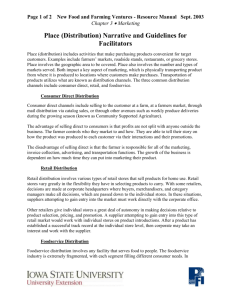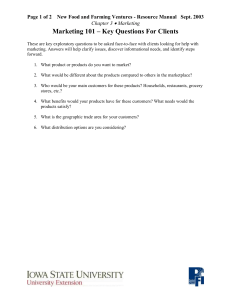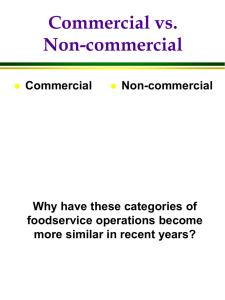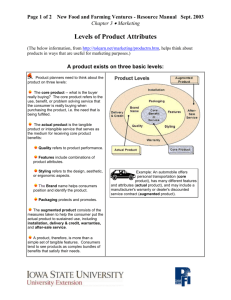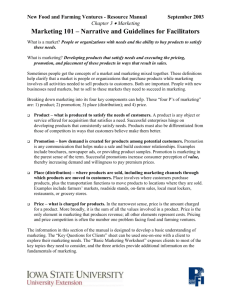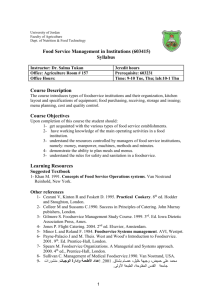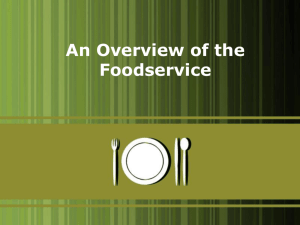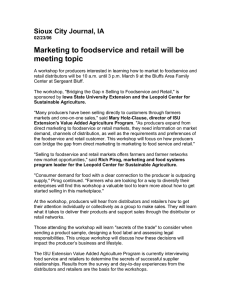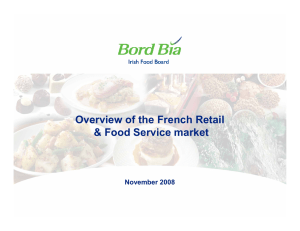The Four P's Of Marketing - Agricultural Marketing Resource Center
advertisement
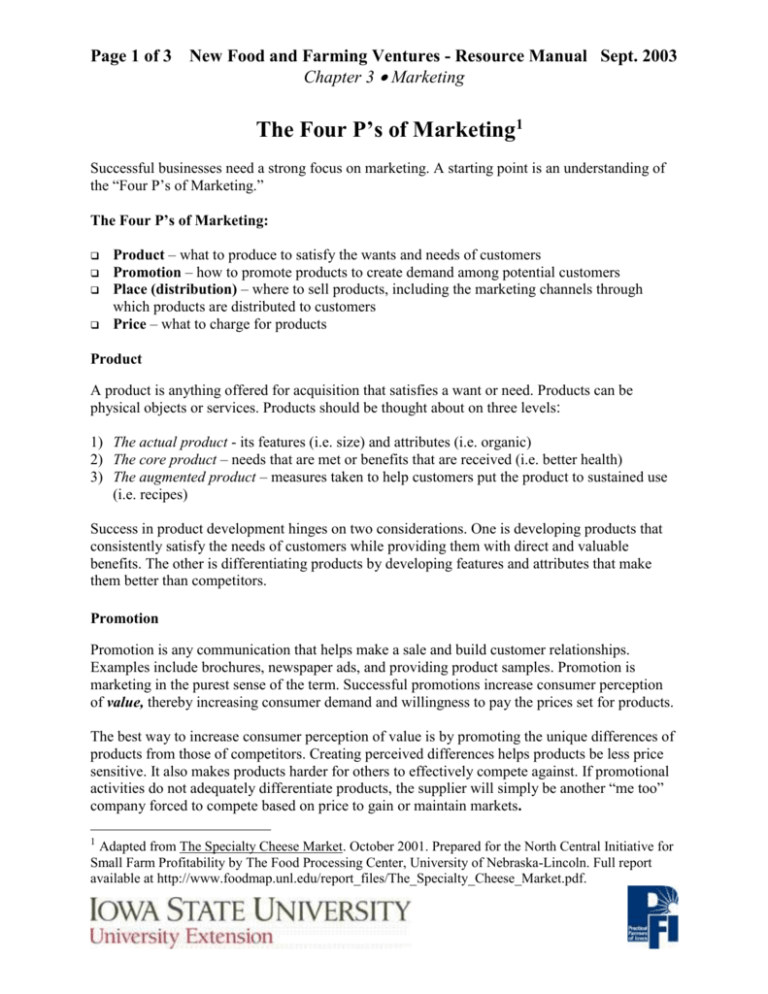
Page 1 of 3 New Food and Farming Ventures - Resource Manual Sept. 2003 Chapter 3 Marketing The Four P’s of Marketing1 Successful businesses need a strong focus on marketing. A starting point is an understanding of the “Four P’s of Marketing.” The Four P’s of Marketing: Product – what to produce to satisfy the wants and needs of customers Promotion – how to promote products to create demand among potential customers Place (distribution) – where to sell products, including the marketing channels through which products are distributed to customers Price – what to charge for products Product A product is anything offered for acquisition that satisfies a want or need. Products can be physical objects or services. Products should be thought about on three levels: 1) The actual product - its features (i.e. size) and attributes (i.e. organic) 2) The core product – needs that are met or benefits that are received (i.e. better health) 3) The augmented product – measures taken to help customers put the product to sustained use (i.e. recipes) Success in product development hinges on two considerations. One is developing products that consistently satisfy the needs of customers while providing them with direct and valuable benefits. The other is differentiating products by developing features and attributes that make them better than competitors. Promotion Promotion is any communication that helps make a sale and build customer relationships. Examples include brochures, newspaper ads, and providing product samples. Promotion is marketing in the purest sense of the term. Successful promotions increase consumer perception of value, thereby increasing consumer demand and willingness to pay the prices set for products. The best way to increase consumer perception of value is by promoting the unique differences of products from those of competitors. Creating perceived differences helps products be less price sensitive. It also makes products harder for others to effectively compete against. If promotional activities do not adequately differentiate products, the supplier will simply be another “me too” company forced to compete based on price to gain or maintain markets. 1 Adapted from The Specialty Cheese Market. October 2001. Prepared for the North Central Initiative for Small Farm Profitability by The Food Processing Center, University of Nebraska-Lincoln. Full report available at http://www.foodmap.unl.edu/report_files/The_Specialty_Cheese_Market.pdf. Page 2 of 3 New Food and Farming Ventures - Resource Manual Sept. 2003 Chapter 3 Marketing Differentiating one’s company is also important. What is the company’s image? Is the company a discount seller or a gourmet producer? It is important to decide on the company’s image and make sure promotional activities accurately portray that image. Place (Distribution) Place (distribution) includes activities that make purchasing products convenient for target customers. Examples include farmers’ markets, roadside stands, restaurants, or grocery stores. Place involves the geographic area to be covered. Place also involves the number and types of markets served. Both impact a key aspect of marketing, which is physically transporting product from where it is produced to locations where customers make purchases. Transportation of products utilizes what are known as distribution channels. The three common distribution channels include consumer direct, retail, and foodservice. Consumer Direct Distribution Consumer direct channels include selling to the customer at a farm, at a farmers market, through mail distribution via catalog sales, or through other avenues such as weekly produce deliveries during the growing season (known as Community Supported Agriculture). The advantage of selling direct to consumers is that profits are not split with anyone outside the business. The farmer controls who they market to and how. They are able to tell their story on how the product was produced to each customer via their interactions and their promotions. The disadvantage of selling direct is that the farmer is responsible for all of the marketing, invoice collection, advertising, and transportation functions. The growth of the business is dependent on how much time they can put into marketing their product. Retail Distribution Retail distribution involves various types of retail stores that sell products for home use. Retail stores vary greatly in the flexibility they have in selecting products to carry. With some retailers, decisions are made at corporate headquarters where buyers, merchandisers, and category managers make all decisions, which are passed down to the individual stores. In these situations, suppliers attempting to gain entry into the market must work directly with the corporate office. Other retailers give individual stores a great deal of autonomy in making decisions relative to product selection, pricing, and promotion. A supplier attempting to gain entry into this type of retail market would work with individual stores on product introductions. After a product has established a successful track record at the individual store level, then corporate may take an interest and work with the supplier. . . . and justice for all The U.S. Department of Agriculture (USDA) prohibits discrimination in all its programs and activities on the basis of race, color, national origin, gender, religion, age, disability, political beliefs, sexual orientation, and marital or family status. (Not all prohibited bases apply to all programs.) Many materials can be made available in alternative formats for ADA clients. To file a complaint of discrimination, write USDA, Office of Civil Rights, Room 326-W, Whitten Building, 14th and Independence Avenue, SW, Washington, DC 20250-9410 or call 202-720-5964. Page 3 of 3 New Food and Farming Ventures - Resource Manual Sept. 2003 Chapter 3 Marketing Foodservice Distribution Foodservice distribution involves any facility that serves food to people. The foodservice industry is extremely fragmented, with each segment filling different consumer needs. In general, foodservice can be partitioned into two sectors: the commercial sector and the noncommercial sector. The commercial sector includes independent and chain restaurants, delis, hotels and professional catering. Menus in these facilities are shaped by the fact that consumers can choose where to eat and what to purchase, which means these facilities are more responsive to consumer demands. The result is that the commercial foodservice sector may be the most lucrative non-direct market for specialty products. Indeed, there has been an increase in the use of these products by restaurant chefs, especially those working in independently owned high-end restaurants. The non-commercial (institutional) segment includes hospitals, nursing homes, schools, and prisons. This is a “captive” market where consumers typically have limited choice in menu selection. Because this is a captive market, they can be less interested in specialty products, although there has been some success in selling products to colleges and universities. Price In the narrowest sense, price is the amount of money charged for a product. More broadly, it is the sum of all the values involved in a product. Increasing customer perception of value through differentiation and effective promotion increases demand for products; premium-priced products not supported by customer demand will fail due to insufficient volume. Price is the only element in an organization’s marketing functions that produces revenue; all other elements represent costs. Price is also one of the most flexible elements of the marketing functions. Unlike product features and distribution channels, price can be changed quickly. Pricing and price competition is the number one problem facing food and farming ventures. A common mistake is setting prices without considering all marketing functions. For example, promotional costs, such as advertising expenses and time spent making sales presentations, need to be built into price. Another significant cost is distribution, or physically moving the product from its place of production to the place where customers make purchases. Costs can also come from broker fees, spoilage, and revenue collection. Any cost involved in the production, promotion, distribution, and servicing of products should be built into prices set for products. It is important to guard against under pricing for another reason: price lends a value to the product in the mind of the customer, and under pricing can lead the consumer to believe the item is of little value. When pricing products, suppliers place a value on their product and company. They are not just selling a product. They are selling a package that includes the unique features and benefits of the product, company, and customer service.
